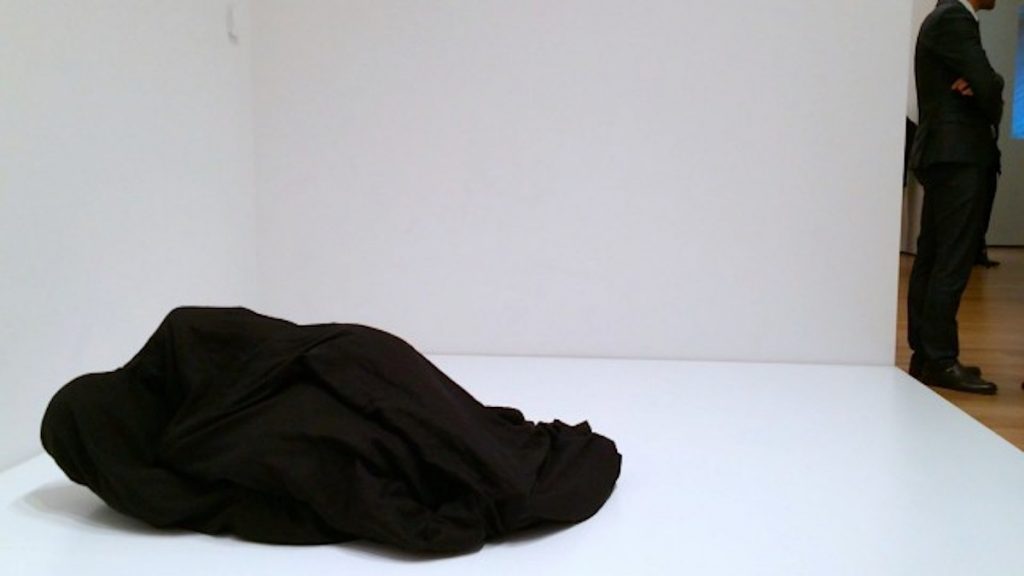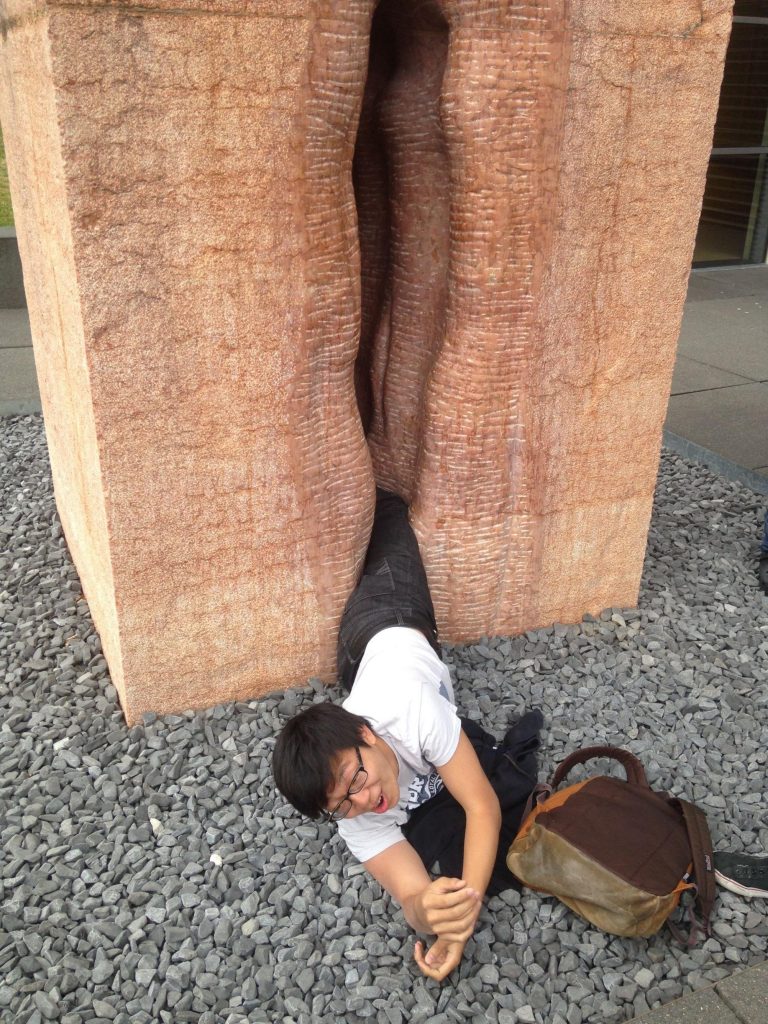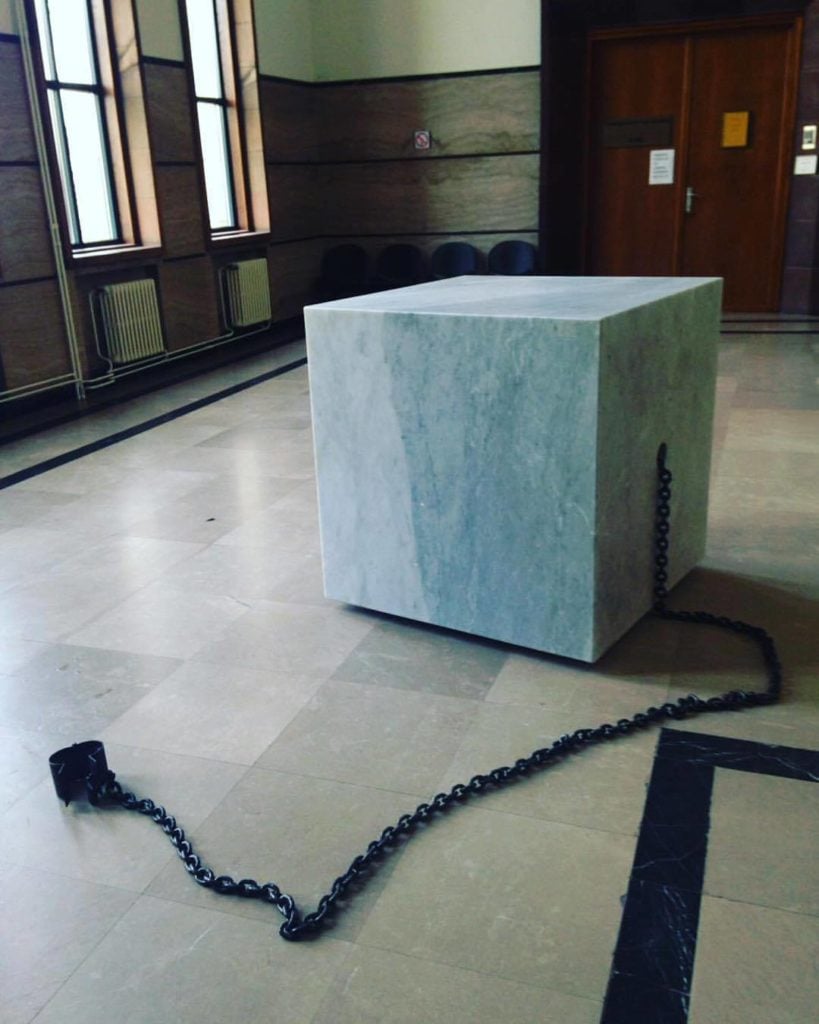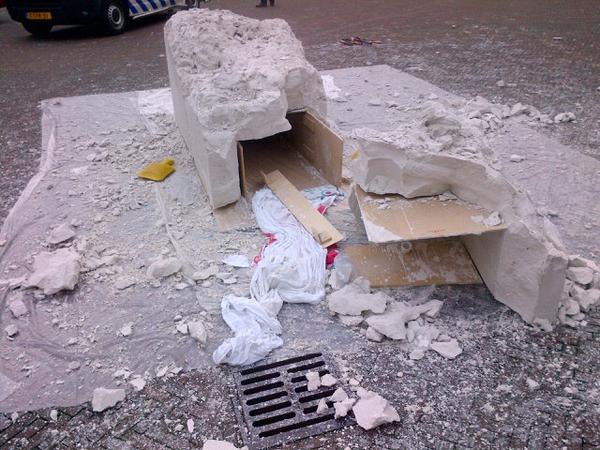Art World
Help! 7 Times People Got Trapped Inside Artworks—Whether by Choice or by Accident
Don't worry, they all got out.

Don't worry, they all got out.

Brian Boucher

If you were visiting Times Square around midnight in January 2017, you were presented with the curious spectacle of a woman’s face displayed all over the digital billboards of the Crossroads of the World. She pressed her face against a pane of glass, smearing it in all directions, distorting her features, smudging her makeup all the while, as if trying to break out.
This was Open My Glade (Flatten), from 2000–17, Pippilotti Rist’s funny and unsettling contribution to Times Square Arts’s “Midnight Moment” series. It was presented in collaboration with the New Museum, where the artist had an exhibition, which Artnet News critic Ben Davis called “absolutely shameless, in a good way.”
Rist may have been referring to the glass ceiling, and to the walls closing in on women in terms of greater restrictions on their bodily autonomy, but the theme of being trapped in an artwork, which her video formally suggests, is a rich one. Artists churning out artworks for a hungry market might be said to be trapped in their own style. And think of Dorian Gray, a libertine in a tale by Oscar Wilde who sells his soul so that he will never grow old, while a painted portrait hidden away in his home records his aging and his every sin.
Furthermore, any art lover knows the feeling of being transfixed by a work of art—pinned down like a butterfly on a board, unable to break free from its spell. After all, a woman was once locked into a German museum overnight after losing track of time.
But a number of times in recent years, people have become literally trapped inside artworks, their troubles symbolizing art’s transfixing power in a whole new way. Typically, they entered by choice, and sometimes they were able to wriggle out on their own, but sometimes professionals with lubricant or power tools had to be summoned.

Blake Gopnik occupies a Yoko Ono piece at MoMA. Courtesy Blake Gopnik.
Visitors to a preview of Yoko Ono’s 2015 retrospective at New York’s Museum of Modern Art may have caught the sight of Artnet News contributor Blake Gopnik wrapped in a black bag on a pedestal as part of Ono’s Bag Piece (1964).
“Your very first emotion is a tiny moment of panic, as you feel trapped and the world fades to black around you,” Gopnik wrote at the time. “How do I get out when I’m done? HELP!”

An American student waiting for firefighters to free him from Fernando de la Jara’s marble vagina sculpture, Chacán-Pi (Making Love), at Germany’s Tübingen University. Photo by Erick Guzman, via Imgur.
Gopnik found it easy enough to get out of Ono’s artwork, but an American student required the assistance of some 22 firefighters to extricate himself from a stone sculpture in the shape of a vulva in 2014.
The 32-ton red Veronese marble sculpture by Fernando de la Jara, Chacán-Pi (Making Love), was meant to symbolize “the gateway to the world,” but just spelled trouble when a nameless American student thought he could get a clever photo by posing as if being born from the narrow crevice in the sculpture, which stands on the campus of Germany’s Tübingen University.
“He just wanted to take a funny picture,” said a friend who posted a delivery room-like photo of first responders working to free the young man. Famous last words.

Jacob Andersen trapped in John Clement’s Caracol. Photo: Kelly Andersen.
“In 21 years in the fire service, I never had an extrication from an art piece,” Dave Bell, fire department captain at the South Carolina resort town of Hilton Head Island, told WJCL. But there’s a first time for everything, and seven-year-old Jacob Anderson gave rise to it in 2015, when he was climbing on a newly installed sculpture, Caracol, by artist John Clement, and got his leg stuck between two parts of the piece.
“The fire department was prepared to saw the sculpture apart, but an ambulance, which had been dispatched to the scene, came bearing surgical lubricant,” as Artnet News reported at the time. “After a generous application, the boy’s leg slid right out, uninjured.”

Mikes Poppe De Profondis (2017). Photo: Mikes Poppe via Facebook.
Artist Mikes Poppe was too clever by half when he devised a 2017 public performance in which he would be chained to a four-ton block of Carrara marble that symbolized the “inescapable burden of history.” The idea was that he would chisel his way through the block of stone, the very same kind used for Michelangelo’s David and countless other artworks, thus freeing himself from that burden. But history’s burden did turn out to be, as the artist himself put it, inescapable, at least with a chisel.
When he missed his deadline for getting through the block of stone, and then missed it again and again, Joanna Devos, the curator who organized the performance, which took place at a courthouse in the Belgian town of Ostend, called in a contractor with power tools to finish the job.

The remains of a failed street art project in which an artist nearly suffocated inside a sculpture. Firefighters had to rescue her. Photo courtesy of the Rotterdam Police Department.
Five artists were taken in for questioning in Rotterdam in 2015 when a public project nearly went tragically wrong. One woman lay down in a box, which her colleagues then layered with plaster, allowing her to breathe through a straw stretching through the drying material. But they panicked when she couldn’t get enough air and called in the fire department, who broke out heavy tools and freed the artist.
The straw-breather was brought in for questioning with the rest of them, a police spokesperson insisting, “It does not matter that she herself chose to allow them to cast her in plaster.”
No reporter managed to reach the artists, so the meaning of their near-fatal gesture may be lost to art history.

Shia LaBeouf, Rönkkö & Turner. Photo: still from YouTube.
Actor-turned-performance artist Shia LaBeouf, along with his collaborators Nastja Säde Rönkkö and Luke Turner, transformed an Oxford University elevator into a self-imposed trap in 2016, for two 24-hour periods on either side of a lecture he gave at the Oxford Union debating society, in a performance called #Elevate.
“Visitors… are invited to address the artists, the debating chamber, and the internet, so that their collective voices may form an extended, expansive and egalitarian Oxford Union address,” read a statement from the artists and Oxford Union.
LaBeouf had no trouble escaping after the performance concluded, presumably pressing the “door open” button.

Ball-Nogues Studio, Talus Dome, in Edmonton, Alberta. Photo by Talusdome. Creative Commons Attribution-Share Alike 4.0 International license.
When 26-year-old Wakeem Courtoreille came upon the $600,000 public artwork in Edmonton, Alberta, Canada, that is commonly referred to as the “Talus Balls,” he gave in to the deeply human, and very dumb, urge to climb it.
That was unfortunate for him, because Talus Dome, by artist duo Benjamin Ball and Gaston Nogues, features spaces between the nearly 1,000 hand-crafted stainless steel spheres that constitute the piece—ideally so that people can see between them, not fall into them. After slipping through a gap in the sculpture, Courtoreille required three emergency teams to free him.
“It’s definitely different than what we would typically use [the jaws of life] for,” Edmonton Fire Rescue Services chief Troy Brady told CTV News.
Rescue workers destroyed one of the globes while getting Courtoreille out, and he damaged several others while climbing the work. He was levied a $5,000 fine and charged with one count of mischief.
Speaking to Global News, Chief Brady had sage advice for any similarly adventurous art lovers: “Maybe just enjoy the art.”
More Trending Stories:
Conservators Find a ‘Monstrous Figure’ Hidden in an 18th-Century Joshua Reynolds Painting
A First-Class Dinner Menu Salvaged From the Titanic Makes Waves at Auction
The Louvre Seeks Donations to Stop an American Museum From Acquiring a French Masterpiece
Meet the Woman Behind ‘Weird Medieval Guys,’ the Internet Hit Mining Odd Art From the Middle Ages
A Golden Rothko Shines at Christie’s as Passion for Abstract Expressionism Endures
Agnes Martin Is the Quiet Star of the New York Sales. Here’s Why $18.7 Million Is Still a Bargain
Mega Collector Joseph Lau Shoots Down Rumors That His Wife Lost Him Billions in Bad Investments